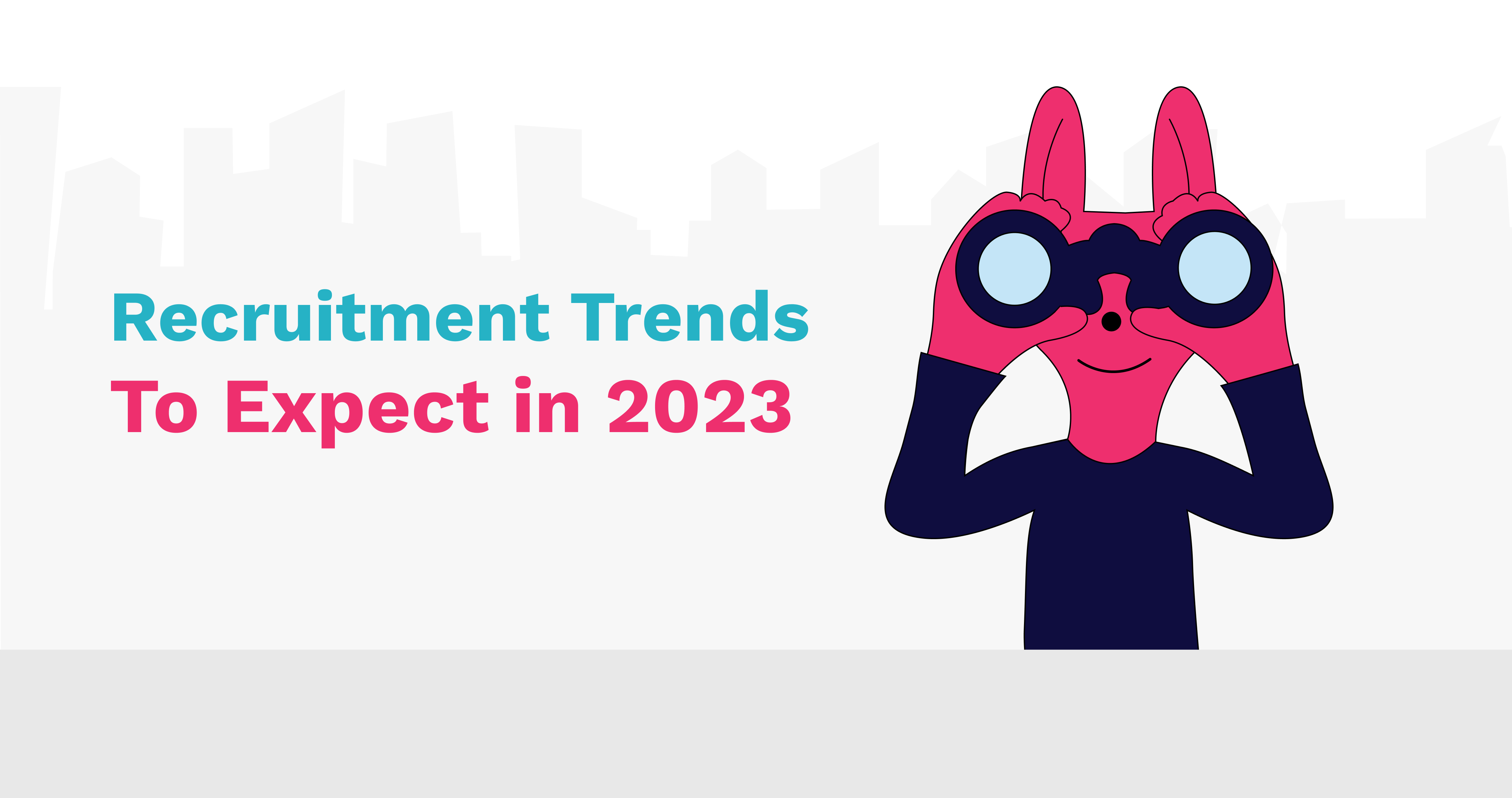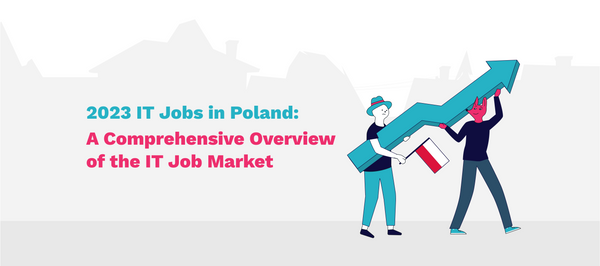Top 10 Recruitment Trends to Follow in 2023
The last two years took a toll on the recruitment industry. The rapid development of technologies and major shifts in the job market created new recruitment trends and the changes that continue to unfold. Recruiters must now become experts in HR tech trends, like virtual recruiting, predictive analytics, and many more to stay afloat and find skillful employees.
In this article, we'll break down the main catalysts of those changes and guide you through the latest recruiting trends in 2023.
Major catalysts for changes in recruitment
New trends in recruitment processes don't exist in a vacuum — they appear for a reason or many reasons. Let’s take a closer look at the key drivers of recent recruiting trends.
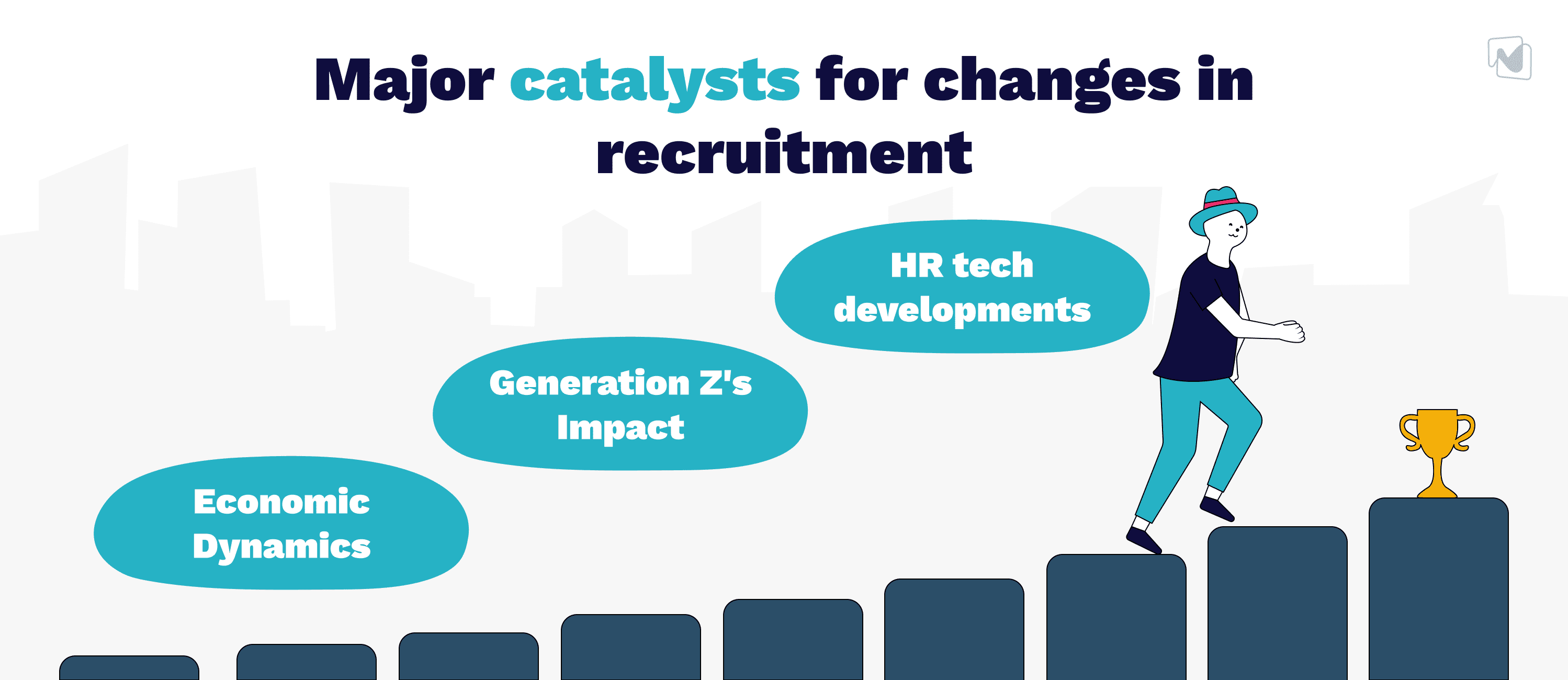
Economic Dynamics
The driving force behind the transformation of recruitment practices is the complex interplay of global economic and societal factors. The lingering effects of the COVID-19 pandemic continue to resonate across industries, economies, and communities, casting a shadow over conventional norms. The disruptions in supply chains, stress on healthcare systems, and the rapid shift towards remote work have left a lasting impact, creating an environment of perpetual uncertainty. Events such as the 2022 Russian invasion of Ukraine have added to the economic turmoil, leading to rising energy costs, inflation, and the looming possibility of a recession.
Looking ahead, economic experts forecast the potential emergence of a recession, which will influence hiring strategies and require organizations to adapt to fluctuating economic conditions. In the realm of talent acquisition, the need to remain flexible and navigate through economic uncertainties becomes paramount.
Generation Z's Impact
One big thing happening in 2023 is the rise of Generation Z – those are the folks born between 1997 and 2012. They're super comfortable with technology since they grew up with it.
Now, because of Generation Z, things are changing in how companies hire new people. These guys like to have flexible work arrangements, they want their jobs to mean something, and they care about being real and honest. So, recruiters, the people who find new employees, have to adjust how they talk and how they show what's great about working for a company. It's like a whole new way of finding the right people for the job.
HR tech developments
In the ever-changing world of recruitment, there's a game-changer on the horizon: HR technology. This cool tech stuff is reshaping how companies find new team members. Thanks to smart tools and computer smarts that have evolved over a few years, hiring managers are now able to focus less on mundane tasks and more on engaging with job seekers. This shift not only streamlines the hiring process but also opens up avenues to identify top talent and map out exciting career paths.
The magic doesn't stop there! The infusion of AI and machine learning adds a new layer of innovation. These smart technologies enhance the experience for job seekers, making the search for job opportunities a smoother journey. Moreover, they help amplify employer branding efforts, showcasing a company's unique culture and values to potential candidates. This digital transformation isn't just about technology; it's about people. It's about creating an ecosystem where HR professionals, recruiters, and business leaders come together to cultivate a company image that values diversity, equity, and inclusion.
As we look ahead, this technological evolution is a game-changer for recruiting teams, HR business partners, and talent acquisition professionals. It's about empowering hiring teams with the right tools to attract, nurture, and retain top talent. This paradigm shift in HR tech isn't just a glimpse into the future; it's the present reality of how companies are strategically positioning themselves for a world of new recruiting trends. So, get ready for a future of recruiting where AI-driven tools and a thoughtful hiring strategy are shaping the path forward.
Related: 5 Ways to Improve the Recruitment Process with HR Tech
10 recruitment trends for 2022
Without further ado, let’s find out which hiring trends will continue to heat up in 2022.

Virtual recruiting
Virtual recruiting was making gains even before COVID-19, but the pandemic has boosted it. Today, many companies rely on virtual recruiting as their primary method. It encompasses searching for candidates on professional platforms, online career forums, and social media, along with conducting virtual interviews and onboarding.
Virtual recruiting is a win-win. It grants employers access to a wide talent pool while expanding career horizons for job seekers. This approach not only speeds up hiring and saves time and money for all parties, but also nurtures company culture and enhances employer branding. As we navigate the dynamic landscape of recruiting trends, virtual hiring emerges as a pivotal force shaping the way employers and candidates connect.
AI recruiting

Amidst economic uncertainty, AI recruiting is gaining traction among HR professionals. This approach harnesses artificial intelligence to automate recruitment tasks like CV screening and interview scheduling. A challenge faced by 52% of HR leaders is pinpointing the best-fit candidates from a vast pool. With AI, recruiters redirect their efforts, focusing on strategic communication with shortlisted candidates rather than CV screening.
AI-driven recruiting is a game-changer. It empowers recruiters to glean insights into candidates' skills and knowledge by analyzing social media and CVs while identifying behavior patterns. As future trends take shape, AI emerges as a tool to navigate the dynamic recruiting landscape, streamlining processes and enhancing decision-making. In a world brimming with open positions and a hunt for hard skills, AI is the key to efficient workforce planning and a successful recruiting function.
Natural language processing (NLP)
In the past, recruiters often spent most of their time looking through hundreds of CVs to fill one position. Because of this, they'd look specifically for keywords and ignore the rest of the content, which is one of the most inefficient ways to choose a candidate.
The field of AI, NLP speeds up the process and guards against subconscious bias while delivering a shortlist of the best-qualified candidates. It uses lexical, semantical, and other kinds of analysis to interpret natural language, including hidden meanings, sentiments, or intent. Today, NLP can handle legal documents, create algorithms that match potential candidates with vacancies, and assist recruiters in repetitive tasks such as scanning through CVs.
Predictive analytics

Predictive analytics allow recruiters to use historic workforce data to their advantage. It considers factors like previous work experience, character traits, and skill sets to detect the candidates who are most likely to succeed at the job. Predictive analytics also helps discover potential candidates who aren’t actively seeking a job but are open to new opportunities. What is more, it can detect current employees who are considering leaving a company. Combined with AI, predictive analytics has the potential to reshape recruitment methods and approaches further.
Social media recruiting
Social media is an indispensable part of our lives for communicating, expressing opinions, shopping and finding new career opportunities, and that’s why using social media for recruiting will only grow in popularity. In the future, companies will pay more attention to engaging candidates through social media, post more photos and videos that aid in recruiting and encourage current employees to share content about new openings. Posting on social media is also another way to strengthen employer branding. Skilled candidates have lots of employment opportunities, and strong employer branding makes your company stand out from the rest.
Referral programs
The hot job market has made the search for candidates a more challenging quest than ever before. That’s where referral programs come in handy. Throughout the last decade, nearly 30% of newly hired employees were found through employee referral programs. These programs are often among the most cost-effective recruitment methods. Often, referred employees are a perfect cultural fit, good performers, and less likely to leave.
Referral programs vary and may include doubled monthly salary, bonuses for successful referrals, phones or laptops as rewards, and so on.
Diverse teams
Remote work made it possible to hire employees based solely on their skills and knowledge instead of their location. As such, workforces become more diverse in terms of culture, race, religion, gender, etc. In turn, diversity increases companies’ productivity, creativity, and profit. Every employee presents different points of view based on their background and experience. Having multiple perspectives on the same problems leads to fast, unexpected, and efficient solutions.
Data analytics
New recruiting trends will also include data analytics tools and applicant tracking software that allow hiring managers to discover patterns for searching, selecting, and hiring candidates. Identifying such patterns helps optimize recruitment processes and enables data-driven decision-making.
With data analytics tools, recruiters can better understand candidates' previous experiences, which can lead to more accurate hiring decisions. Data analytics will help detect recruitment patterns and shape future recruitment practices.
Agile workforce

An agile workforce consists of full-time, part-time, and freelance employees in a company that wants to adapt to the changing business landscape quickly. A scheme like this opens more opportunities for retaining expertise, promoting innovation, and increasing collaboration between the company and professionals in different fields. In this case, any technological, operational, or strategic changes can be faced without losses.
Read more: 7 Tips on Developing a Talent Sourcing Strategy And Why You Need One
Generation Z recruitment
Some of us still imagine Gen Z as edgy teenagers who have weird tastes in music and clothes. But it’s 2021 out there, and Gen Z has already grown up and infiltrated the job market. And it turns out they have pretty different views on jobs and careers compared to millennials.
To attract Gen Z talent, you need to adapt your recruitment strategies to their values:
- Prioritize diversity: Gen Z candidates consider a company's position on diversity a key factor in their decision to work there.
- Foster flexibility and remote work opportunities: Work-life balance, safety, and a focus on quality over quantity are priorities for Gen Z, especially in the post-pandemic world.
- Automate and digitize the recruitment process: Gen Zs don’t remember life without technology, and they tend to trust companies that incorporate modern technologies into their processes more than companies that don’t.
- Focus on selling the role: Gen Z candidates are well aware of their value and the number of opportunities waiting for them. You have to be persuasive in explaining why your offer is the best one.
If you want to bring Gen Z to your company, impress them. Show them that you care not only about making money, but also about ensuring the professional and personal development of all employees.
Navigating the Recruitment Landscape in 2023: Dos and Don'ts for Success
In this fast-paced environment, staying ahead requires a keen understanding of the dos and don'ts that can make or break your recruitment efforts. As the landscape evolves, it's crucial for recruiters and business owners to navigate these changes effectively. Let's delve into a comprehensive list of dos and don'ts that will empower you to navigate the intricate world of talent acquisition with finesse and precision.
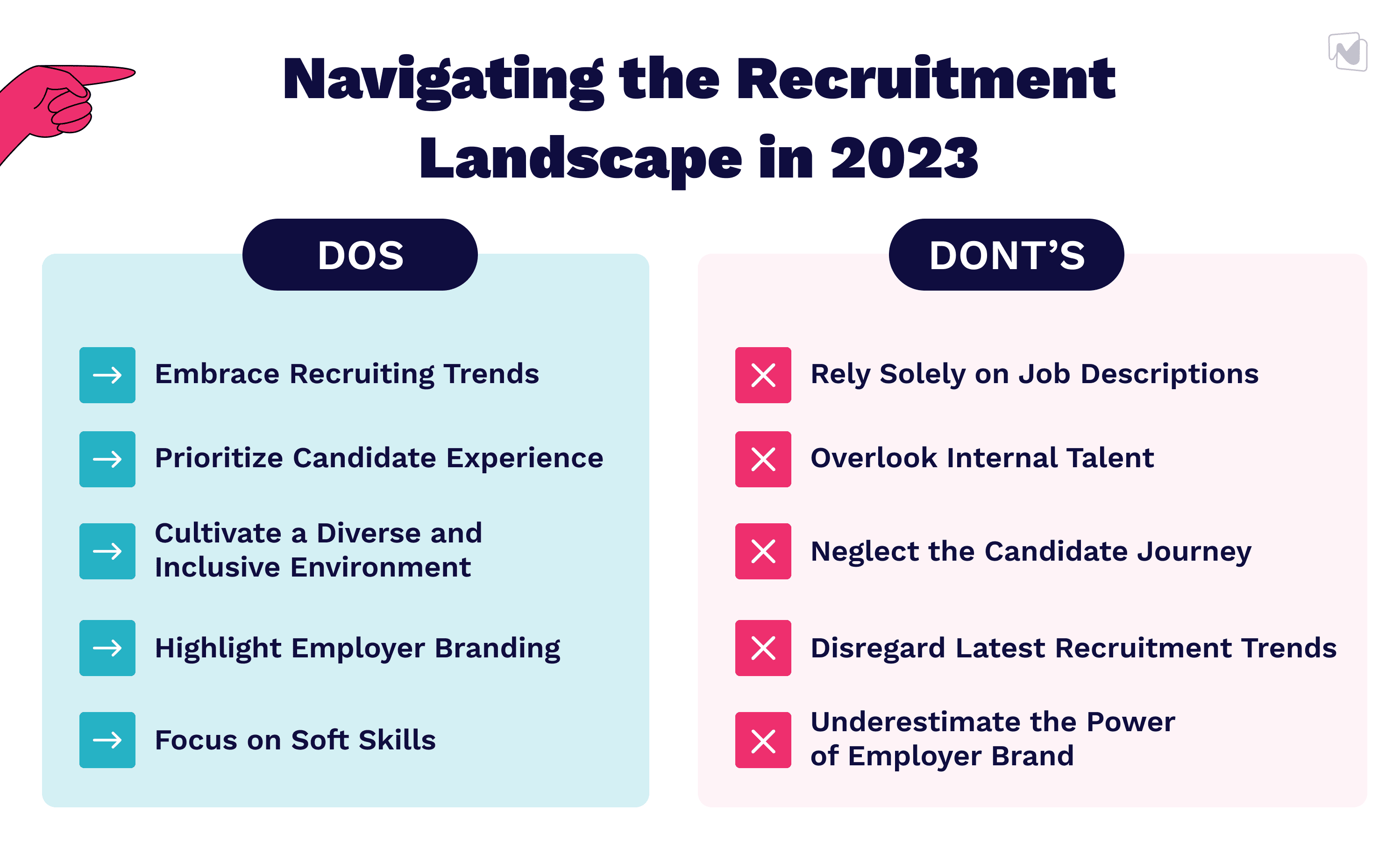
Dos:
Embrace Recruiting Trends:
Stay informed about the latest recruiting trends to remain competitive and relevant in attracting top talent. Adapting to evolving preferences of job seekers is key to building a strong team.
Prioritize Candidate Experience:
Ensure that every interaction with candidates, from initial contact to the final decision, is seamless and positive. A smooth and respectful candidate experience enhances your employer brand.
Cultivate a Diverse and Inclusive Environment:
Create a workplace culture that values diversity, equity, and inclusion. A diverse workforce brings varied perspectives and fosters innovation.
Highlight Employer Branding:
Showcase your company's values, mission, and culture in your recruitment efforts. A strong employer brand attracts candidates who align with your organization's vision.
Focus on Soft Skills:
While technical skills are essential, don't underestimate the importance of soft skills like communication and teamwork. These skills contribute to a harmonious and productive work environment.
Don'ts:
Rely Solely on Job Descriptions:
Don't limit your recruitment efforts to generic job descriptions. Craft compelling and accurate descriptions that capture the essence of the role and your company.
Overlook Internal Talent:
Don't ignore the potential of your existing employees. Internal recruiting can uncover hidden talent and boost employee morale.
Neglect the Candidate Journey:
Avoid a disconnected and impersonal recruitment process. Ensure candidates feel valued and respected at every stage of their journey.
Disregard Latest Recruitment Trends:
Ignoring emerging trends can hinder your ability to attract and retain top talent. Keep your finger on the pulse of industry shifts.
Underestimate the Power of Employer Brand:
Your employment brand can make or break your recruitment efforts. Don't underestimate its impact on attracting the right candidates.
As the labor market evolves and the world of recruiting continues to change, these dos and don'ts provide a roadmap for success in 2023. By harnessing the power of the latest trends, prioritizing the candidate experience, and building a strong company image, recruiters and business owners can position themselves at the forefront of the dynamic recruiting landscape.
Wrap up
The recruitment industry is now less about paper-pushing and more about diversity, modern technologies, and adaptation. Rapid changes of the last few years brought about new trends in recruitment. You have to stretch beyond traditional channels to find the perfect fit. Use newly-developed recruitment software and apps, promote your company on social media, and encourage current employees to spread the word about opportunities at your company among their network.
At MagicHire, we always follow recruitment industry trends and utilize the best technologies to find the most experienced and skillful candidates for you. Don’t hesitate to contact us to find your new teammates!
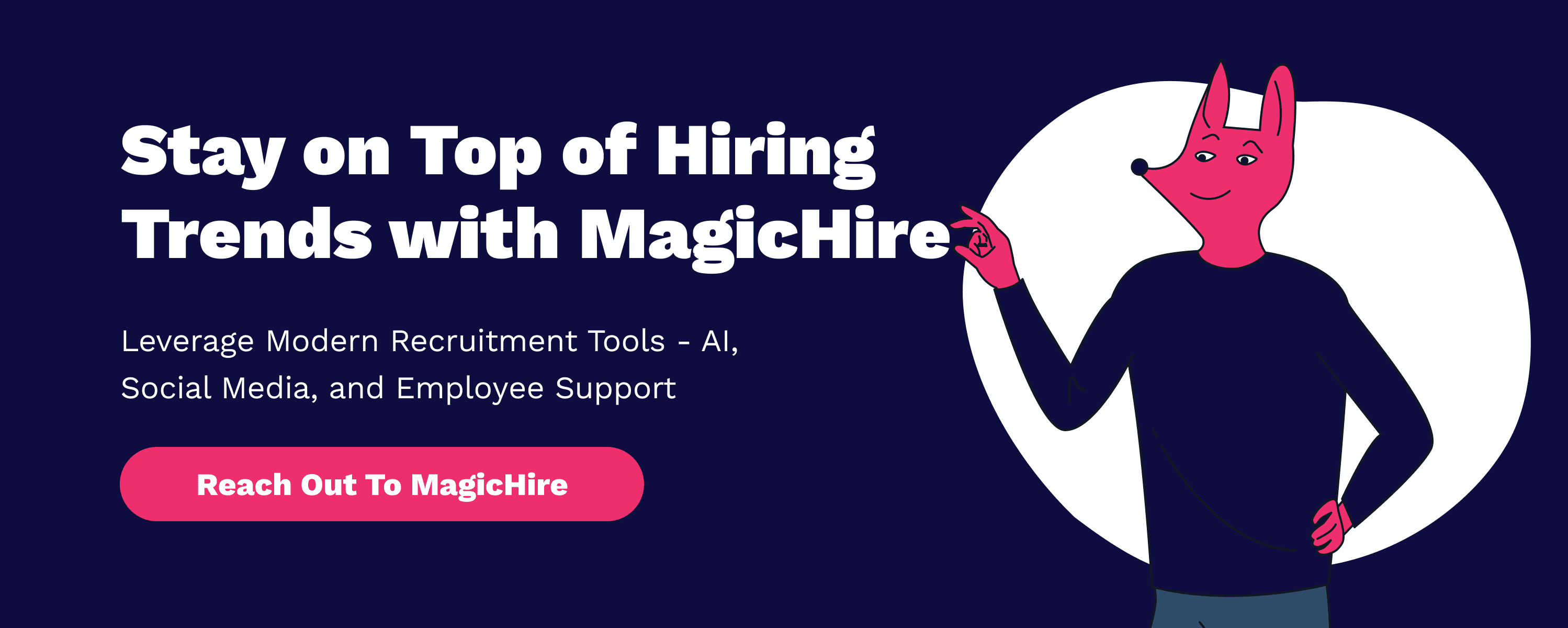
FAQ
What are the key recruitment trends 2023 to follow?
In 2023, the recruitment landscape is experiencing significant shifts, driven by factors like economic dynamics, the rise of Generation Z, and the integration of HR tech. These trends are shaping how companies attract and retain top talent while adapting to the needs of hiring managers, recruiting trends, and effective talent acquisition.
What is natural language processing (NLP) in recruitment?
NLP is an AI field that interprets and analyzes natural language, helping recruiters sift through CVs more efficiently. It aids in identifying the most expert based on comprehensive analysis, beyond keyword matching, and optimizing recruitment marketing efforts.
What is a hiring trend?
A hiring trend refers to a prevailing pattern or shifts in the methods, strategies, and practices used by organizations to attract, select, and onboard new employees. These trends are influenced by factors such as technological advancements, economic conditions, and evolving candidate preferences.
What do candidates want in 2023?
In 2023, candidates are seeking more than just a job; they are looking for an organization that aligns with their values and offers a positive work environment. Creating an accurate job description that vividly represents the role and company culture is crucial in drawing in such a candidate. Candidates prioritize aspects such as welcoming company culture, opportunities for career advancement, and the development of soft skills.
How can hiring managers attract employees in 2023
To attract employees in 2023, organizations must stay attuned to the latest recruiting trends. Crafting enticing job descriptions that highlight not only the role's responsibilities but also the organization's values and mission is key. Emphasizing soft skills, which are increasingly valued, and showcasing a commitment to diversity and inclusion can also attract a diverse pool of candidates.


